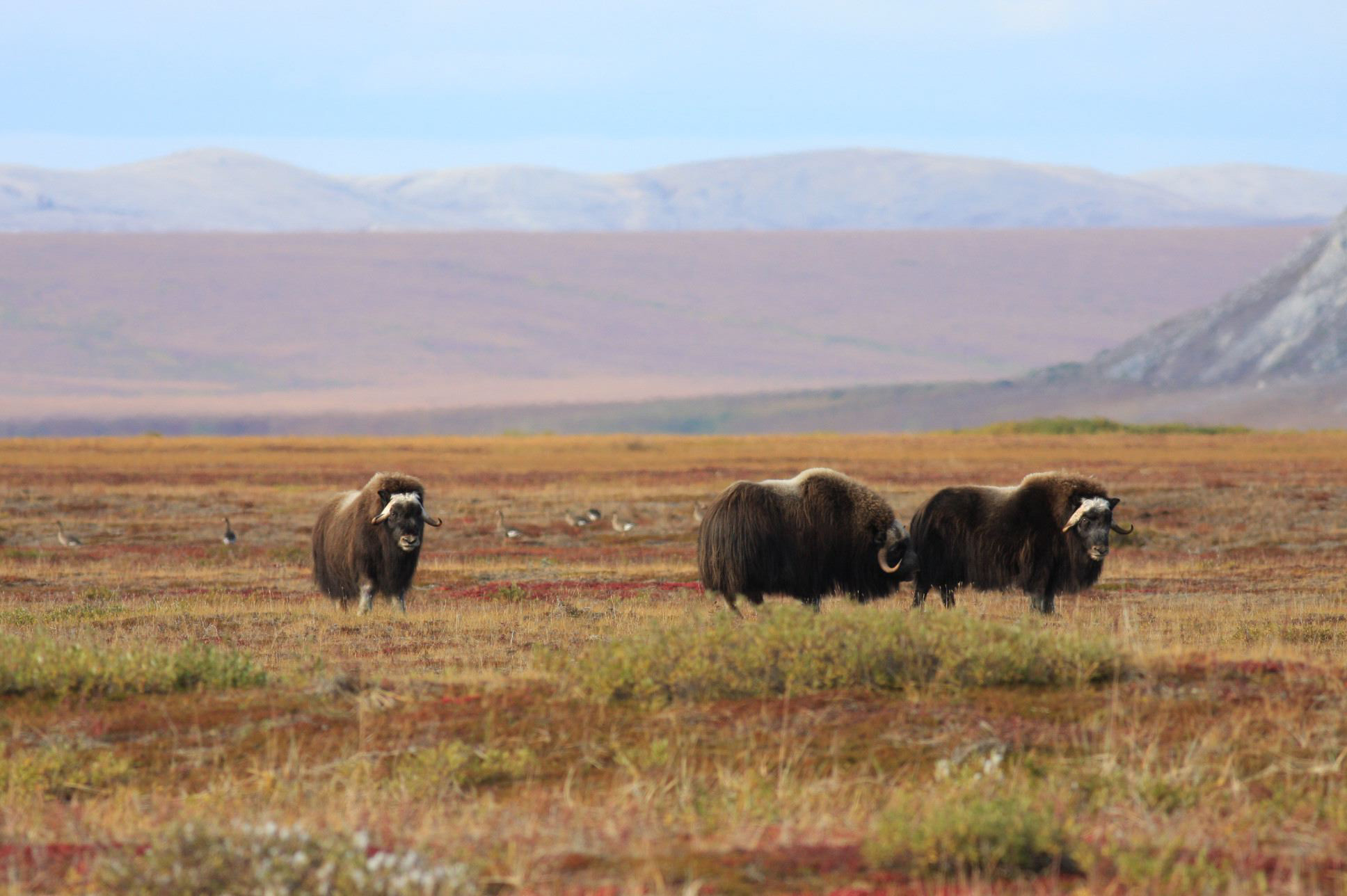A bacterium common to farm animals is threatening the Arctic’s muskoxen
Erysipelothrix rhusiopathiae is linked to recent die-offs.

Muskoxen, shaggy-haired Arctic survivors of the Pleistocene era, have faced a lot of challenges since the end of the last Ice Age.
Now there is another: a bacterium more common to southern farm animals like pigs and chickens. Signs of exposure to bacterium Erysipelothrix rhusiopathiae have been found in muskoxen around the north, and peak exposure periods coincided with regional population declines, according to a newly published study in the journal PLOS ONE.
Erysipelothrix rhusiopathiae causes infections that are sometimes fatal for animals. The bacterium is blamed for recent die-offs on Banks Island and Victoria Island in Canada’s Northwest Territories, areas that are home to large but declining muskox populations. The animal deaths tied to the bacterium occurred in summer and were described as sudden and unrelated to lack of food.
As information came in about summer die-offs there and elsewhere, scientists from Canada and Alaska teamed up to try to understand the scope of infection in muskoxen.
“When it showed up in Banks and Victoria Islands, it was kind of a big deal,” said Layne Adams, a U.S. Geological Survey biologist and co-author of the new study who, in his work in northwest Alaska, also encountered a summer die-off of muskoxen.
The newly published study analyzed 818 blood or serum samples collected from populations in Alaska and Canada. More than a quarter of them tested positive for signs of exposure to the bacterium, or seropositivity.
The bacterium has been in muskox populations for a long time, according to the study, but there are signs that exposure rates are rising.
Seropositive samples were found in Alaska specimens preserved from the 1970s, the oldest on hand. But other patterns have started to emerge, with geographic variations. In the Alaska samples, there was increasing seroprevalance after 2000. Canadian samples showed seroprevalance increases that coincided with the die-offs. For one of those populations, on Victoria Island, sample seroprevalence increased from 4.3 percent in 2011 to 41.7 percent in 2015, the study said.
“In some populations, it seems like the exposure to the bacterium has been increasing,” said Fabien Mavrot, a University of Calgary veterinarian and the study’s lead author. But there are gaps in the information, so broad conclusions are premature, he said. “We cannot say for sure it’s a generalized trend for every muskox population we have tested,” he said.
Erysipelothrix rhusiopathiae is zoonotic. “It’s a bacterium that is very able to jump from one species to another,” Mavrot said.
Though better known as a bacterium infecting farm animals, it has been found wild animals like deer, wolves and foxes. It can be carried by fish, marine mammals and birds, Mavrot said. In the far north, caribou and muskoxen walking over sea ice can potentially carry it from island to island, he said.
In humans, infections are considered occupational hazards for veterinarians, farm workers, hunters and other people who work with animals. The usual result of infection is a skin rash, which is readily treated with antibiotics.
For muskoxen, Erysipelothrix rhusiopathiae is adding to a series of stressors for the animals that, in combination, can make them vulnerable.
“Everything that can impact the health of the animals can make them more susceptible to disease,” Mavrot said.
Among the stressors are rain-on-snow events, which are occurring more frequently as the climate warms. Some winter die-offs — notably the death of 20,000 Banks Island muskoxen in 2003 — have been blamed on rain that creates icing of the landscape. Even moderate rain-on-snow incidents can have lasting effects, with apparent negative impacts on the development of baby muskoxen born after those events, according to research by Joel Berger of Colorado State University.
Sudden icing has caused other problems. A late-winter storm surge in northwestern Alaska in 2011 killed at least 32 muskoxen in Bering Land Bridge National Preserve. Their carcasses were found encased in ice.
Predators pose another threat to muskoxen. The Alaska Department of Fish and Game collected evidence of increased kills of muskoxen by grizzly bears in northeastern Arctic Alaska through the early 2000s, though that might be attributable to a decline of other prey for the region’s grizzlies.
A lot of things mixing together seem to have caused the decline in eastern North Slope muskox populations from 1999 to 2007, according to a team of scientists. The team’s study, published in 2016, evaluated various disease pathogens, food availability and other factors. It said the region’s muskoxen were being subjected to the “complex stressors of our modern times.”
Muskoxen endured plenty of troubles in the old days, too.
Much of their habitat vanished after the end of the last ice age. By the mid-1800s, they had disappeared from northern Asia and Europe, according to the Alaska Department of Fish and Game. By the 1920s, there were wiped out in Alaska, victims of overhunting but also possibly newly unfavorable climate conditions.
The return of muskoxen to Alaska came from a 1930s project that brought 34 animals on a long odyssey by steamship, train and barge from Greenland to Nunivak Island in the Bering Sea. Descendants of those travelers from Greenland were transplanted decades later to other parts of Alaska.
Today, the status of the world’s muskoxen is mixed, according to a review of the most recent surveys.
Of the 55 geographic locations of muskox populations, only six were identified as being in decline, but those include the important, large and hard-hit large populations on Banks Island and Victoria Island. Many smaller geographic populations are increasing, but there are big gaps in knowledge. In the study, which estimated that there are 170,000 muskoxen in the world, the status for nearly a third of the 55 populations was classified as “unknown.”